lane assist VOLVO S60 INSCRIPTION 2016 Owner´s Manual
[x] Cancel search | Manufacturer: VOLVO, Model Year: 2016, Model line: S60 INSCRIPTION, Model: VOLVO S60 INSCRIPTION 2016Pages: 344, PDF Size: 7.24 MB
Page 8 of 344
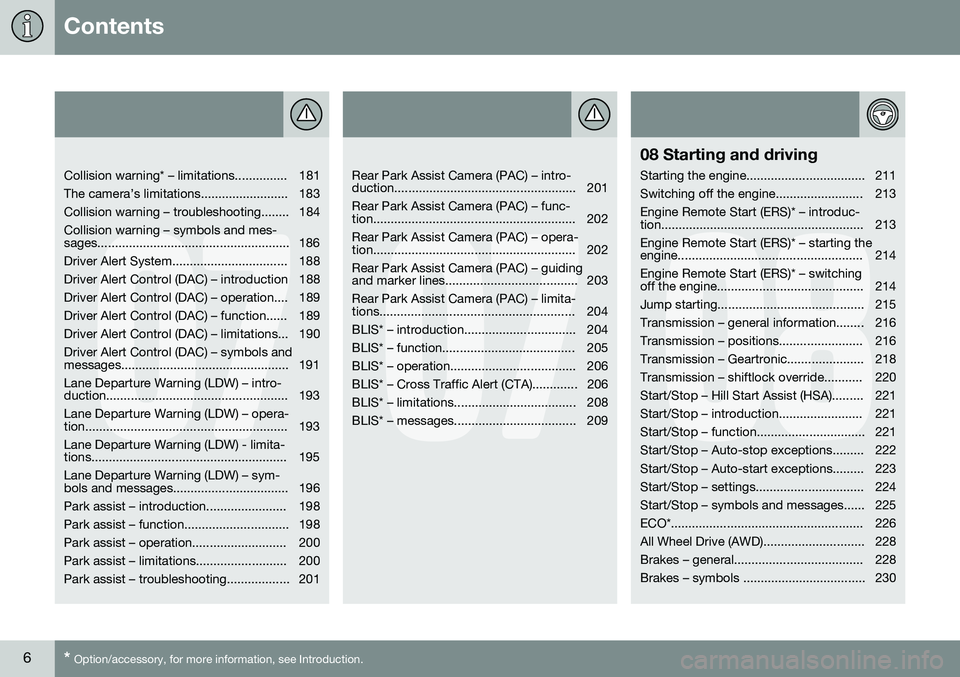
Contents
6* Option/accessory, for more information, see Introduction.
07
Collision warning* – limitations............... 181
The camera’s limitations......................... 183
Collision warning – troubleshooting........ 184Collision warning – symbols and mes-
sages....................................................... 186
Driver Alert System................................. 188
Driver Alert Control (DAC) – introduction 188
Driver Alert Control (DAC) – operation.... 189
Driver Alert Control (DAC) – function...... 189
Driver Alert Control (DAC) – limitations... 190Driver Alert Control (DAC) – symbols and
messages................................................ 191 Lane Departure Warning (LDW) – intro-
duction.................................................... 193 Lane Departure Warning (LDW) – opera-
tion.......................................................... 193 Lane Departure Warning (LDW) - limita-
tions........................................................ 195 Lane Departure Warning (LDW) – sym-
bols and messages................................. 196
Park assist – introduction....................... 198
Park assist – function.............................. 198
Park assist – operation........................... 200
Park assist – limitations.......................... 200
Park assist – troubleshooting.................. 201
07
Rear Park Assist Camera (PAC) – intro-
duction.................................................... 201 Rear Park Assist Camera (PAC) – func-
tion.......................................................... 202 Rear Park Assist Camera (PAC) – opera-
tion.......................................................... 202 Rear Park Assist Camera (PAC) – guiding
and marker lines...................................... 203 Rear Park Assist Camera (PAC) – limita-
tions........................................................ 204
BLIS* – introduction................................ 204
BLIS* – function...................................... 205
BLIS* – operation.................................... 206
BLIS* – Cross Traffic Alert (CTA)............. 206
BLIS* – limitations................................... 208
BLIS* – messages................................... 209
08
08 Starting and driving
Starting the engine.................................. 211
Switching off the engine......................... 213Engine Remote Start (ERS)* – introduc-
tion.......................................................... 213 Engine Remote Start (ERS)* – starting the
engine..................................................... 214 Engine Remote Start (ERS)* – switching
off the engine.......................................... 214
Jump starting.......................................... 215
Transmission – general information........ 216
Transmission – positions........................ 216
Transmission – Geartronic...................... 218
Transmission – shiftlock override........... 220
Start/Stop – Hill Start Assist (HSA)......... 221
Start/Stop – introduction........................ 221
Start/Stop – function............................... 221
Start/Stop – Auto-stop exceptions......... 222
Start/Stop – Auto-start exceptions......... 223
Start/Stop – settings............................... 224
Start/Stop – symbols and messages...... 225
ECO*....................................................... 226
All Wheel Drive (AWD)............................. 228
Brakes – general..................................... 228
Brakes – symbols ................................... 230
Page 152 of 344
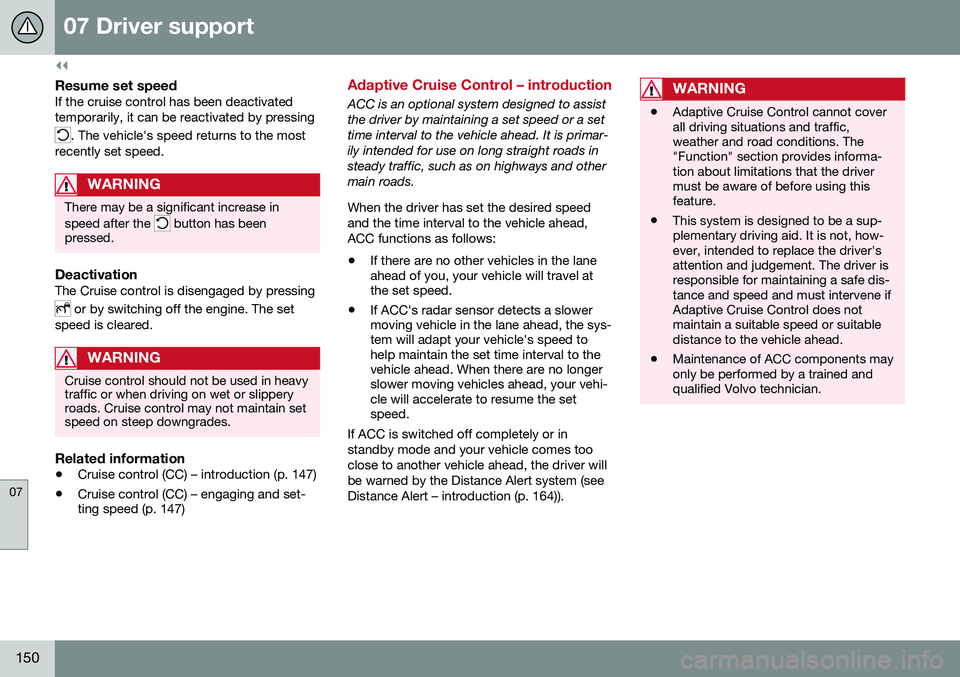
||
07 Driver support
07
150
Resume set speedIf the cruise control has been deactivated temporarily, it can be reactivated by pressing
. The vehicle's speed returns to the most
recently set speed.
WARNING
There may be a significant increase in speed after the
button has been
pressed.
DeactivationThe Cruise control is disengaged by pressing
or by switching off the engine. The set
speed is cleared.
WARNING
Cruise control should not be used in heavy traffic or when driving on wet or slipperyroads. Cruise control may not maintain setspeed on steep downgrades.
Related information
• Cruise control (CC) – introduction (p. 147)
• Cruise control (CC) – engaging and set- ting speed (p. 147)
Adaptive Cruise Control – introduction
ACC is an optional system designed to assist the driver by maintaining a set speed or a settime interval to the vehicle ahead. It is primar-ily intended for use on long straight roads insteady traffic, such as on highways and othermain roads. When the driver has set the desired speed and the time interval to the vehicle ahead,ACC functions as follows:
• If there are no other vehicles in the lane ahead of you, your vehicle will travel atthe set speed.
• If ACC's radar sensor detects a slowermoving vehicle in the lane ahead, the sys-tem will adapt your vehicle's speed tohelp maintain the set time interval to thevehicle ahead. When there are no longerslower moving vehicles ahead, your vehi-cle will accelerate to resume the setspeed.
If ACC is switched off completely or in standby mode and your vehicle comes tooclose to another vehicle ahead, the driver willbe warned by the Distance Alert system (seeDistance Alert – introduction (p. 164)).WARNING
• Adaptive Cruise Control cannot cover all driving situations and traffic,weather and road conditions. The"Function" section provides informa-tion about limitations that the drivermust be aware of before using thisfeature.
• This system is designed to be a sup-plementary driving aid. It is not, how-ever, intended to replace the driver'sattention and judgement. The driver isresponsible for maintaining a safe dis-tance and speed and must intervene ifAdaptive Cruise Control does notmaintain a suitable speed or suitabledistance to the vehicle ahead.
• Maintenance of ACC components mayonly be performed by a trained andqualified Volvo technician.
Page 159 of 344

07 Driver support
07
}}
157
Adaptive Cruise Control – passing another vehicle
Passing another vehicleIf your vehicle’s speed is being regulated by ACC and the driver indicates that he/shewould like to pass the vehicle ahead by usingthe left turn signal, ACC can assist by accel-
erating briefly. This function is active at speeds above approximately 45 mph (70 km/h).
WARNING
Please be aware that this function will also cause the vehicle to accelerate briefly incertain situations other than passinganother vehicle, for example using the leftturn signal to indicate a lane change or aturn toward a highway exit at speedsabove approximately 45 mph (70 km/h).
Related information
• Adaptive Cruise Control – introduction (p. 150)
Adaptive Cruise Control (ACC) – Queue Assist
Queue Assist is an added ACC feature that is linked to your vehicle's automatic transmis-sion.
IntroductionQueue Assist is an added ACC feature that islinked to your vehicle's automatic transmis-sion. Queue Assist consists of the following func- tions: •Enhanced speed interval (including when the vehicle is at a complete stop or ismoving at speed below 18 mph(30 km/h))
• Automatic standby mode when ACCchanges target vehicles
• No automatic braking when at a standstill
• The parking brake is applied automati-cally
Please note that the lowest speed that can be set is 18 mph (30 km/h), although ACC canmaintain a set speed/distance to a vehicleahead down to a standstill. Queue Assistconsists of the following features:
Enhanced speed interval
NOTE
The driver's door must be closed and the driver's seat belt must be fastened beforeACC can be put in active mode. If the driv-er's seat belt is taken off or if the driver'sdoor is opened, ACC will return to standbymode.
Your vehicle can maintain the set time interval to the vehicle ahead at any permissiblespeed, including a complete stop. In order to activate ACC at speeds below 18 mph (30 km/h):
• The vehicle ahead must be within a rea- sonable distance (not farther away thanapprox. 100 ft/30 meters)
• The lowest speed that can be selected is18 mph (30 km/h), although ACC will alsohelp maintain the set time interval to thevehicle ahead at lower speeds, includinga complete stop.
During short stops (less than approximately 3 seconds) in slow-moving traffic, your vehi-cle will begin moving again automatically assoon as the vehicle ahead begins to move. If it takes more than 3 seconds for the vehicle ahead to begin moving, ACC will be automat-ically go into standby mode.
Page 195 of 344
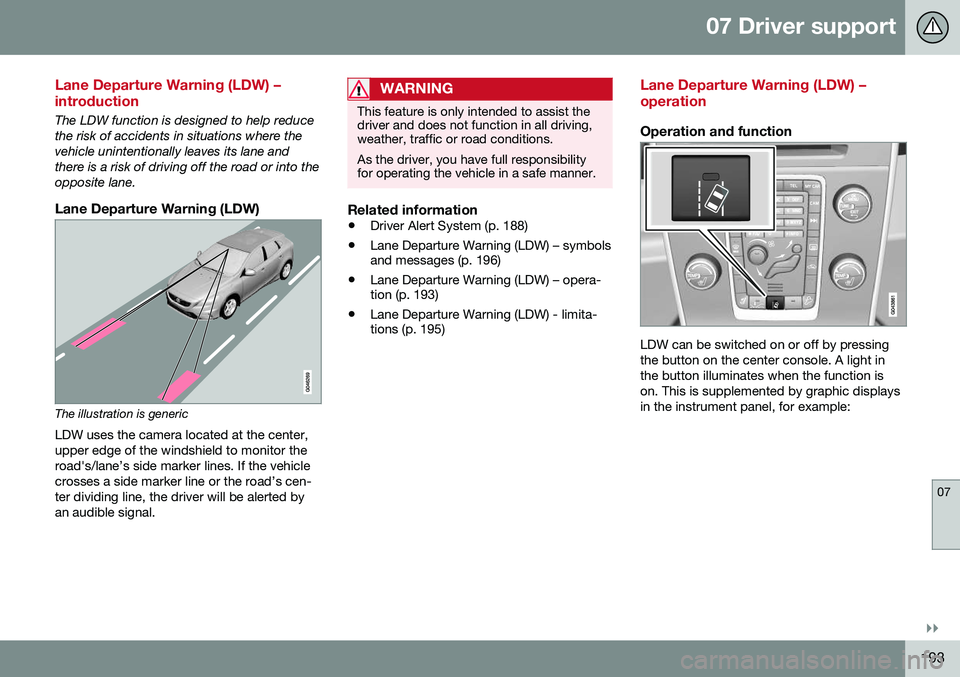
07 Driver support
07
}}
193
Lane Departure Warning (LDW) – introduction
The LDW function is designed to help reduce the risk of accidents in situations where thevehicle unintentionally leaves its lane andthere is a risk of driving off the road or into theopposite lane.
Lane Departure Warning (LDW)
The illustration is genericLDW uses the camera located at the center, upper edge of the windshield to monitor theroad's/lane’s side marker lines. If the vehiclecrosses a side marker line or the road’s cen-ter dividing line, the driver will be alerted byan audible signal.
WARNING
This feature is only intended to assist the driver and does not function in all driving,weather, traffic or road conditions. As the driver, you have full responsibility for operating the vehicle in a safe manner.
Related information
• Driver Alert System (p. 188)
• Lane Departure Warning (LDW) – symbols and messages (p. 196)
• Lane Departure Warning (LDW) – opera-tion (p. 193)
• Lane Departure Warning (LDW) - limita-tions (p. 195)
Lane Departure Warning (LDW) – operation
Operation and function
LDW can be switched on or off by pressing the button on the center console. A light inthe button illuminates when the function ison. This is supplemented by graphic displaysin the instrument panel, for example:
Page 206 of 344
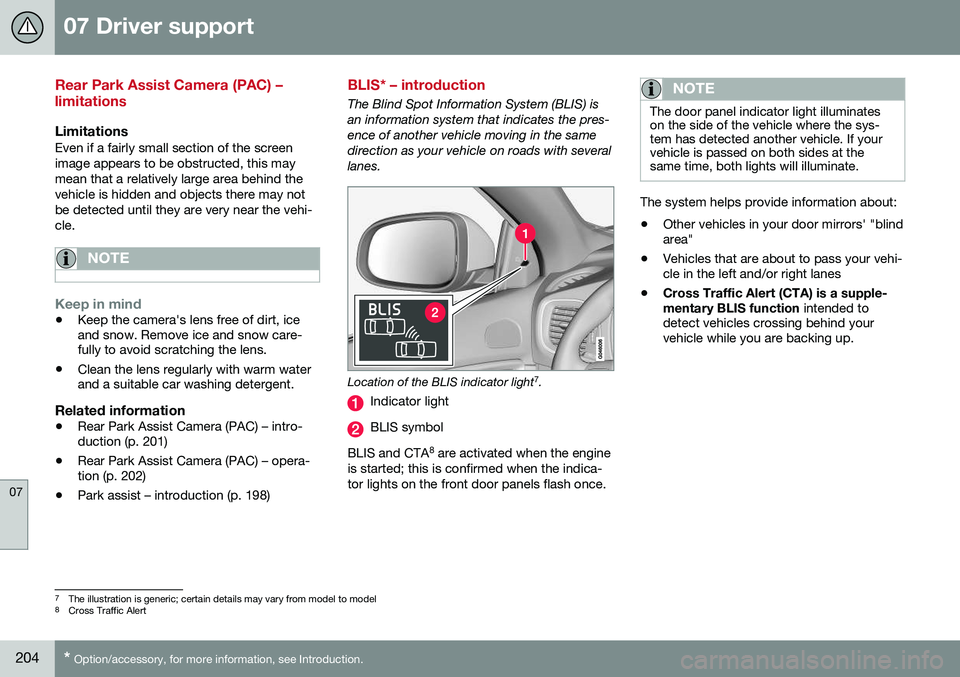
07 Driver support
07
204* Option/accessory, for more information, see Introduction.
Rear Park Assist Camera (PAC) – limitations
LimitationsEven if a fairly small section of the screen image appears to be obstructed, this maymean that a relatively large area behind thevehicle is hidden and objects there may notbe detected until they are very near the vehi-cle.
NOTE
Keep in mind
• Keep the camera's lens free of dirt, ice and snow. Remove ice and snow care-fully to avoid scratching the lens.
• Clean the lens regularly with warm waterand a suitable car washing detergent.
Related information
•Rear Park Assist Camera (PAC) – intro-duction (p. 201)
• Rear Park Assist Camera (PAC) – opera-tion (p. 202)
• Park assist – introduction (p. 198)
BLIS* – introduction
The Blind Spot Information System (BLIS) is an information system that indicates the pres-ence of another vehicle moving in the samedirection as your vehicle on roads with severallanes.
Location of the BLIS indicator light 7
.
Indicator light
BLIS symbol
BLIS and CTA 8
are activated when the engine
is started; this is confirmed when the indica- tor lights on the front door panels flash once.
NOTE
The door panel indicator light illuminates on the side of the vehicle where the sys-tem has detected another vehicle. If yourvehicle is passed on both sides at thesame time, both lights will illuminate.
The system helps provide information about:
• Other vehicles in your door mirrors' "blind area"
• Vehicles that are about to pass your vehi-cle in the left and/or right lanes
• Cross Traffic Alert (CTA) is a supple- mentary BLIS function
intended to
detect vehicles crossing behind your vehicle while you are backing up.
7 The illustration is generic; certain details may vary from model to model
8 Cross Traffic Alert
Page 209 of 344
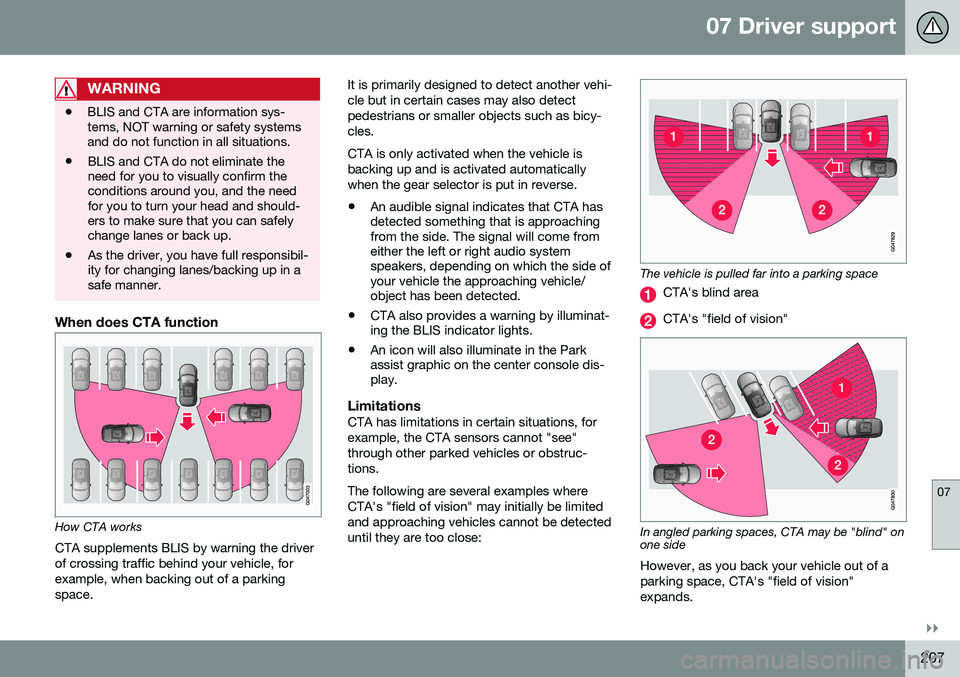
07 Driver support
07
}}
207
WARNING
•BLIS and CTA are information sys- tems, NOT warning or safety systemsand do not function in all situations.
• BLIS and CTA do not eliminate theneed for you to visually confirm theconditions around you, and the needfor you to turn your head and should-ers to make sure that you can safelychange lanes or back up.
• As the driver, you have full responsibil-ity for changing lanes/backing up in asafe manner.
When does CTA function
How CTA works
CTA supplements BLIS by warning the driver of crossing traffic behind your vehicle, forexample, when backing out of a parkingspace. It is primarily designed to detect another vehi-cle but in certain cases may also detectpedestrians or smaller objects such as bicy-cles. CTA is only activated when the vehicle is backing up and is activated automaticallywhen the gear selector is put in reverse.
• An audible signal indicates that CTA has detected something that is approachingfrom the side. The signal will come fromeither the left or right audio systemspeakers, depending on which the side ofyour vehicle the approaching vehicle/object has been detected.
• CTA also provides a warning by illuminat-ing the BLIS indicator lights.
• An icon will also illuminate in the Parkassist graphic on the center console dis-play.
LimitationsCTA has limitations in certain situations, for example, the CTA sensors cannot "see"through other parked vehicles or obstruc-tions. The following are several examples where CTA's "field of vision" may initially be limitedand approaching vehicles cannot be detecteduntil they are too close:
The vehicle is pulled far into a parking space
CTA's blind area
CTA's "field of vision"
In angled parking spaces, CTA may be "blind" on one side
However, as you back your vehicle out of a parking space, CTA's "field of vision"expands.